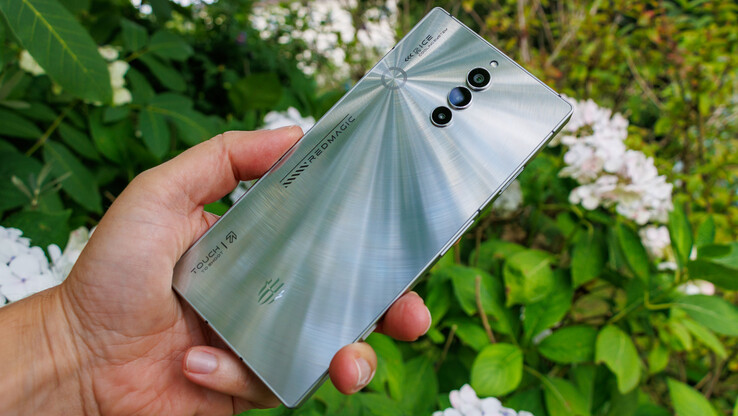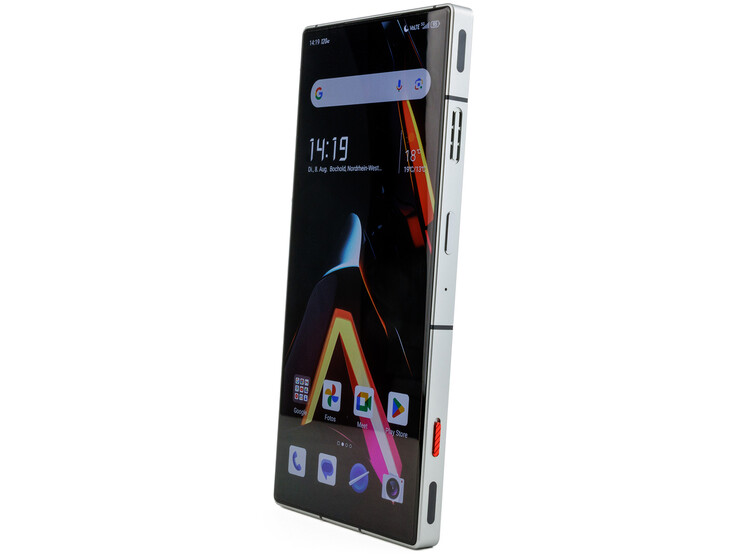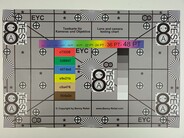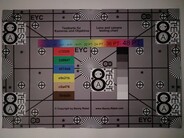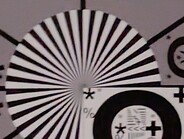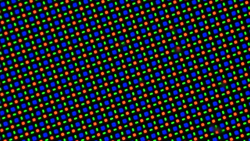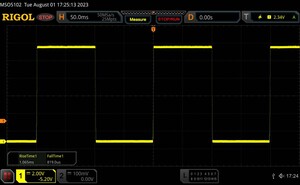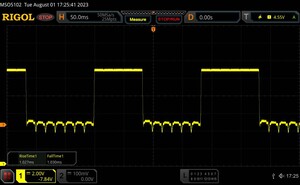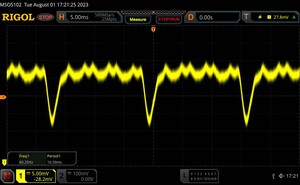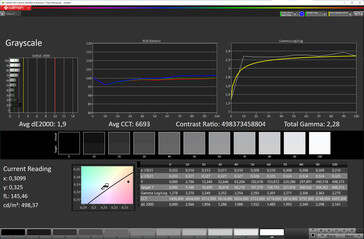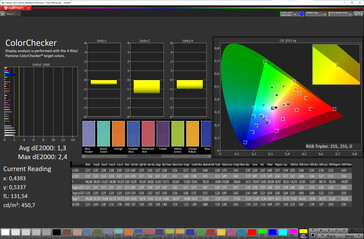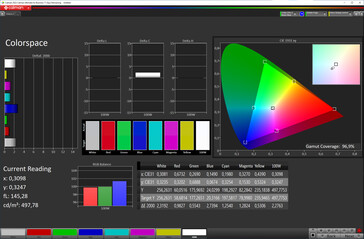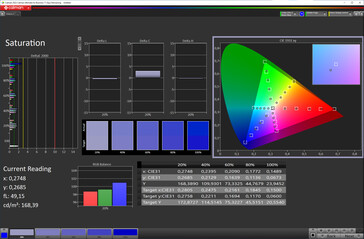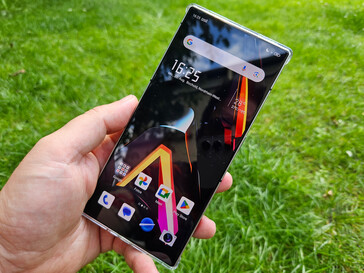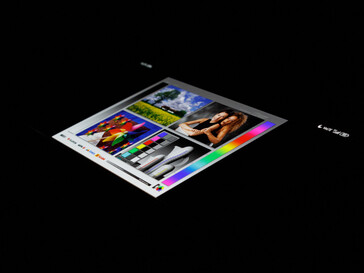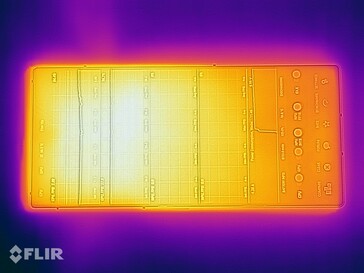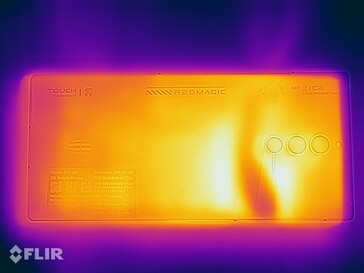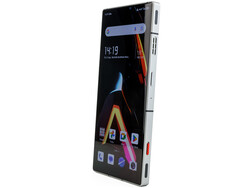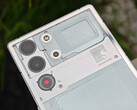Nubia RedMagic 8S Pro review - Gaming smartphone gets better fan control
Possible competitors in comparison
Rating | Date | Model | Weight | Drive | Size | Resolution | Price |
|---|---|---|---|---|---|---|---|
| 88.3 % v7 (old) | 08 / 2023 | Nubia RedMagic 8S Pro SD 8 Gen 2, Adreno 740 | 228 g | 512 GB UFS 4.0 Flash | 6.80" | 2480x1116 | |
| 85.9 % v7 (old) | 02 / 2023 | Nubia RedMagic 8 Pro SD 8 Gen 2, Adreno 740 | 228 g | 256 GB UFS 4.0 Flash | 6.80" | 2480x1116 | |
| 90.2 % v7 (old) | 05 / 2023 | Asus ROG Phone 7 Ultimate SD 8 Gen 2, Adreno 740 | 239 g | 512 GB UFS 4.0 Flash | 6.78" | 2448x1080 | |
| 85.9 % v7 (old) | 06 / 2022 | Xiaomi Poco F4 GT SD 8 Gen 1, Adreno 730 | 210 g | 256 GB UFS 3.1 Flash | 6.67" | 2400x1080 |
Case and features - RedMagic 8S Pro with new design
A fundamental innovation of the RedMagic 8S Pro is its new design, which differs both from the predecessor 7S Pro as well as the sister model 8 Pro. The 8S Pro is much more angular and is available in the design variants Midnight (12 GB RAM, 256 GB UFS 4.0, 649 Euros), Platinum (16 GB RAM, 512 GB UFS 4.0, 779 Euros), and Aurora (16 GB RAM, 512 GB UFS 4.0, 799 Euros). Our test device is the Platinum version, which is reminiscent of Beskar steel due to its bar shape and the metallic glossy casing. All versions now feature the LED-equipped fan.
The workmanship is good and convinces with tight and even gaps. The display-to-surface ratio of 89 percent is on a very good level and has been improved again, which is partly due to the camera under the display (UDC). The two touch surfaces on the right long side can be configured as additional input elements for games and again feature a sampling rate of 520 Hz.
Communication, software and operation - Gaming phone with Wi-Fi 7
The mobile connectivity of the RedMagic 8S Pro is inconspicuous in the test and the smartphone can fall back on a broad frequency band support. The telephony features are good when held to the ear, but the suppression of ambient noise is rather mediocre. With Wi-Fi 7, the smartphone supports the most modern WLAN standard and also shows a strong improvement in connection tests. The transmission rates are very good in the 6 GHz network, but only VHT80 is used in the 2.4 and 5.0 GHz networks.
The RedMagic smartphone ships with Google Android 13 and the RedMagic OS 8.0 interface. The security patches are up to June 1, 2023 at the time of the test and thus are still quite up-to-date. The manufacturer assures the update to Android 14, and there will also be security patches for up to two years. These will be rolled out every two months in the first six months and every three months thereafter.
Biometric security is provided by an optical fingerprint scanner integrated into the display, which does its job satisfactorily and can even measure the pulse. Alternatively or additionally, a less secure facial recognition via the front camera can be used. Besides the two additional capacitive shoulder buttons, there is also a prominent red button in the bezel that switches the smartphone to a special gaming interface. Settings for the individual games can be made there and possibly connected accessories can be managed.
| Networking | |
| Nubia RedMagic 8S Pro | |
| iperf3 transmit AXE11000 | |
| iperf3 receive AXE11000 | |
| iperf3 transmit AXE11000 6GHz | |
| iperf3 receive AXE11000 6GHz | |
| Nubia RedMagic 8 Pro | |
| iperf3 transmit AXE11000 | |
| iperf3 receive AXE11000 | |
| iperf3 transmit AXE11000 6GHz | |
| iperf3 receive AXE11000 6GHz | |
| Asus ROG Phone 7 Ultimate | |
| iperf3 transmit AXE11000 | |
| iperf3 receive AXE11000 | |
| iperf3 transmit AXE11000 6GHz | |
| iperf3 receive AXE11000 6GHz | |
| Xiaomi Poco F4 GT | |
| iperf3 transmit AXE11000 | |
| iperf3 receive AXE11000 | |
| iperf3 transmit AXE11000 6GHz | |
| iperf3 receive AXE11000 6GHz | |
Cameras - Solid setup from the RedMagic 8 Pro
The camera setup is identical to that of the sister model RedMagic 8 Pro. There is an under-display camera (UDC) on the front, which is barely visible. The pictures taken with this camera are not outstanding, but more than sufficient.
The triple camera on the back has an additional ultra wide-angle and a macro lens. The 50 MPix main camera takes good pictures in daylight with comparatively natural color reproduction, but the additional lenses have a rather mediocre quality.
Videos are recorded in high-resolution 8K at best with the main lens. Only Full HD is possible on the front.
Image comparison
Choose a scene and navigate within the first image. One click changes the position on touchscreens. One click on the zoomed-in image opens the original in a new window. The first image shows the scaled photograph of the test device.
Main cameraMain cameraUltra wide-angle5x ZoomLow Light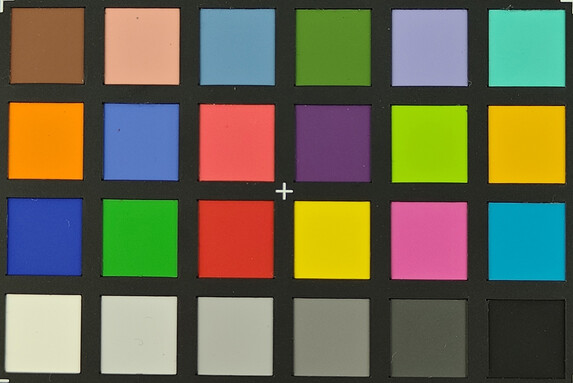
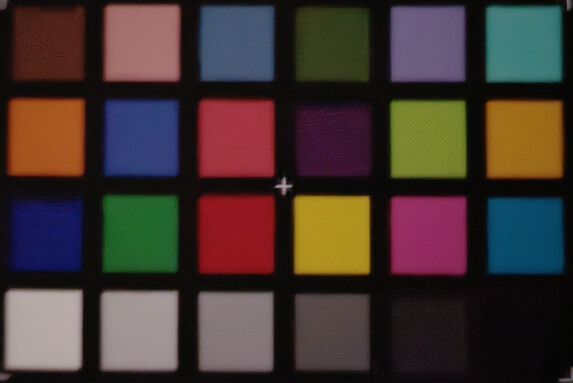
Display - RedMagic 8S Pro with better adjusted 120 Hz OLED
The OLED display of the RedMagic 8S Pro presents itself technically identical to that of its sister model 8 Pro on the spec sheet but shows a much more natural color reproduction in the measurements. In return, it is not quite as bright, but the difference is only measurable.
The 8S Pro achieves up to 787 cd/m² with an activated ambient light sensor in a pure white display. If the bright surfaces are evenly distributed (APL18), the brightness climbs up to 932 cd/m². A maximum of 524 cd/m² is possible when the brightness is manually controlled.
Nubia uses permanent DC dimming to prevent OLED flickering. The frequency of 60 Hz is quite low, but the modulation level is low and the amplitude curve is even.
| |||||||||||||||||||||||||
Brightness Distribution: 98 %
Center on Battery: 775 cd/m²
Contrast: ∞:1 (Black: 0 cd/m²)
ΔE ColorChecker Calman: 1.3 | ∀{0.5-29.43 Ø4.77}
ΔE Greyscale Calman: 1.9 | ∀{0.09-98 Ø5}
99.6% sRGB (Calman 2D)
Gamma: 2.28
CCT: 6693 K
| Nubia RedMagic 8S Pro AMOLED, 2480x1116, 6.8" | Nubia RedMagic 8 Pro AMOLED, 2480x1116, 6.8" | Asus ROG Phone 7 Ultimate AMOLED, 2448x1080, 6.8" | Xiaomi Poco F4 GT AMOLED, 2400x1080, 6.7" | |
|---|---|---|---|---|
| Response Times | 43% | 37% | 48% | |
| Response Time Grey 50% / Grey 80% * (ms) | 2.06 ? | 0.87 ? 58% | 1.29 ? 37% | 0.89 ? 57% |
| Response Time Black / White * (ms) | 1.88 ? | 1.37 ? 27% | 1.2 ? 36% | 1.14 ? 39% |
| PWM Frequency (Hz) | 60 | 60 | 513 | 121.4 |
| Screen | -49% | 12% | -5% | |
| Brightness middle (cd/m²) | 775 | 811 5% | 1010 30% | 807 4% |
| Brightness (cd/m²) | 778 | 817 5% | 1016 31% | 806 4% |
| Brightness Distribution (%) | 98 | 91 -7% | 95 -3% | 99 1% |
| Black Level * (cd/m²) | ||||
| Colorchecker dE 2000 * | 1.3 | 2.9 -123% | 1.3 -0% | 1.2 8% |
| Colorchecker dE 2000 max. * | 2.4 | 4.7 -96% | 2.5 -4% | 3.1 -29% |
| Greyscale dE 2000 * | 1.9 | 3.4 -79% | 1.6 16% | 2.2 -16% |
| Gamma | 2.28 96% | 2.39 92% | 2.24 98% | 2.2 100% |
| CCT | 6693 97% | 6390 102% | 6405 101% | 6439 101% |
| Total Average (Program / Settings) | -3% /
-26% | 25% /
18% | 22% /
9% |
* ... smaller is better
Display Response Times
| ↔ Response Time Black to White | ||
|---|---|---|
| 1.88 ms ... rise ↗ and fall ↘ combined | ↗ 1.065 ms rise | |
| ↘ 0.819 ms fall | ||
| The screen shows very fast response rates in our tests and should be very well suited for fast-paced gaming. In comparison, all tested devices range from 0.1 (minimum) to 240 (maximum) ms. » 9 % of all devices are better. This means that the measured response time is better than the average of all tested devices (20.2 ms). | ||
| ↔ Response Time 50% Grey to 80% Grey | ||
| 2.06 ms ... rise ↗ and fall ↘ combined | ↗ 1.027 ms rise | |
| ↘ 1.03 ms fall | ||
| The screen shows very fast response rates in our tests and should be very well suited for fast-paced gaming. In comparison, all tested devices range from 0.165 (minimum) to 636 (maximum) ms. » 9 % of all devices are better. This means that the measured response time is better than the average of all tested devices (31.6 ms). | ||
Screen Flickering / PWM (Pulse-Width Modulation)
| Screen flickering / PWM detected | 60 Hz | ||
The display backlight flickers at 60 Hz (worst case, e.g., utilizing PWM) . The frequency of 60 Hz is very low, so the flickering may cause eyestrain and headaches after extended use. In comparison: 53 % of all tested devices do not use PWM to dim the display. If PWM was detected, an average of 8081 (minimum: 5 - maximum: 343500) Hz was measured. | |||
Measurement series with fixed zoom level and different brightness settings
Performance, emissions and battery life - You brake, you lose
The RedMagic 8S Pro is powered by the Snapdragon 8 Gen 2 and can draw on 12 or 16 GB of working memory, depending on the model. The gaming smartphone's performance is excellent and remains absolutely stable in every situation due to the integrated fan. Nubia has improved the fan control a bit because it does not sound as shrill under full load anymore, but it is almost as loud as in the 8 Pro. By switching to the Burnout benchmark for simulating full load, the RedMagic 8S Pro is now also really loud on the surface.
The two speakers do a decent job. Due to the fan, however, headphones are more suitable for gaming, especially since the audio jack proves to be quite low-noise (SPL: 75.61 dBFS). Broad support of audio codecs (SBC, AAC, LC3, aptX, aptX HD, aptX Adaptive, aptX TWS+, and LDAC) is also offered for wireless headphones.
| Octane V2 - Total Score | |
| Nubia RedMagic 8 Pro (Edge 108) | |
| Nubia RedMagic 8S Pro (Edge 115) | |
| Nubia RedMagic 8S Pro (Chrome 115) | |
| Average of class Smartphone (2228 - 126661, n=194, last 2 years) | |
| Average Qualcomm Snapdragon 8 Gen 2 (19870 - 65418, n=25) | |
| Asus ROG Phone 7 Ultimate (Chrome 112.0.5615.48) | |
| Xiaomi Poco F4 GT (MS Edge 102) | |
| Nubia RedMagic 8S Pro | Nubia RedMagic 8 Pro | Asus ROG Phone 7 Ultimate | Xiaomi Poco F4 GT | Average 512 GB UFS 4.0 Flash | Average of class Smartphone | |
|---|---|---|---|---|---|---|
| AndroBench 3-5 | 6% | 13% | -28% | 5% | -29% | |
| Sequential Read 256KB (MB/s) | 3576.35 | 3556.62 -1% | 3429.17 -4% | 1832.34 -49% | 3689 ? 3% | 2235 ? -38% |
| Sequential Write 256KB (MB/s) | 2682.03 | 2719.64 1% | 3061.82 14% | 1482.42 -45% | 3092 ? 15% | 1871 ? -30% |
| Random Read 4KB (MB/s) | 369.76 | 393.88 7% | 450.1 22% | 328.58 -11% | 385 ? 4% | 297 ? -20% |
| Random Write 4KB (MB/s) | 479.52 | 551.93 15% | 572.05 19% | 457.69 -5% | 474 ? -1% | 343 ? -28% |
Temperature
(-) The maximum temperature on the upper side is 55.8 °C / 132 F, compared to the average of 35.2 °C / 95 F, ranging from 21.9 to 247 °C for the class Smartphone.
(-) The bottom heats up to a maximum of 52.5 °C / 127 F, compared to the average of 34 °C / 93 F
(+) In idle usage, the average temperature for the upper side is 28 °C / 82 F, compared to the device average of 32.9 °C / 91 F.
| 3DMark | |
| Wild Life Extreme Stress Test | |
| Nubia RedMagic 8S Pro | |
| Nubia RedMagic 8 Pro | |
| Asus ROG Phone 7 Ultimate | |
| Xiaomi Poco F4 GT | |
| Wild Life Stress Test Stability | |
| Nubia RedMagic 8 Pro | |
| Nubia RedMagic 8S Pro | |
| Asus ROG Phone 7 Ultimate | |
| Xiaomi Poco F4 GT | |
| Wild Life Unlimited Stress Test Stability | |
| Nubia RedMagic 8 Pro | |
Fan
Speaker
Nubia RedMagic 8S Pro audio analysis
(+) | speakers can play relatively loud (92.4 dB)
Bass 100 - 315 Hz
(-) | nearly no bass - on average 19.6% lower than median
(+) | bass is linear (5.4% delta to prev. frequency)
Mids 400 - 2000 Hz
(±) | higher mids - on average 6.6% higher than median
(+) | mids are linear (5.1% delta to prev. frequency)
Highs 2 - 16 kHz
(±) | higher highs - on average 8.2% higher than median
(+) | highs are linear (5.6% delta to prev. frequency)
Overall 100 - 16.000 Hz
(±) | linearity of overall sound is average (19.9% difference to median)
Compared to same class
» 32% of all tested devices in this class were better, 7% similar, 61% worse
» The best had a delta of 11%, average was 35%, worst was 134%
Compared to all devices tested
» 50% of all tested devices were better, 7% similar, 42% worse
» The best had a delta of 4%, average was 24%, worst was 134%
Asus ROG Phone 7 Ultimate audio analysis
(+) | speakers can play relatively loud (90.7 dB)
Bass 100 - 315 Hz
(-) | nearly no bass - on average 17.2% lower than median
(±) | linearity of bass is average (7% delta to prev. frequency)
Mids 400 - 2000 Hz
(+) | balanced mids - only 3.5% away from median
(+) | mids are linear (3.3% delta to prev. frequency)
Highs 2 - 16 kHz
(+) | balanced highs - only 4.7% away from median
(+) | highs are linear (3.3% delta to prev. frequency)
Overall 100 - 16.000 Hz
(+) | overall sound is linear (13.7% difference to median)
Compared to same class
» 1% of all tested devices in this class were better, 1% similar, 98% worse
» The best had a delta of 11%, average was 35%, worst was 134%
Compared to all devices tested
» 14% of all tested devices were better, 4% similar, 82% worse
» The best had a delta of 4%, average was 24%, worst was 134%
Battery life
| Battery Runtime - WiFi Websurfing | |
| Average of class Smartphone (12.1 - 54.1, n=208, last 2 years) | |
| Nubia RedMagic 8 Pro | |
| Asus ROG Phone 7 Ultimate | |
| Nubia RedMagic 8S Pro | |
| Xiaomi Poco F4 GT | |
Pros
Cons
Verdict - RedMagic 8S Pro is the performance king
The RedMagic 8S Pro presents itself as a real thoroughbred gamer in the test and can uncompromisingly call up its performance due to its integrated fan. Unfortunately, this also means that the surface can get quite hot.
The additional shoulder sensors are a real added value when gaming, and the front-facing camera underneath the display (UDC) means that there is nothing that could interfere with the view of the content.
The Nubia RedMagic 8S Pro is currently the fastest smartphone!
In general, the RedMagic smartphone proves to be a well-rounded overall package that also handles NFC, Bluetooth 5.3, Wi-Fi 7, and 5G. However, compromises have to be made in the camera setup. The speakers are decent, but here you notice the 8S Pro's lower price compared to the ROG Phone 7, and the same applies to the audio jack.
Besides the Asus smartphone, however, the RedMagic 8 Pro is also an interesting alternative. It is on the same level in terms of price and hardly differs technically. At most, the design can be a deciding factor here.
Price and availability
The RedMagic 8S Pro can be purchased directly from the manufacturer starting at $649. Alternatively, it is also available from Amazon US, a variant with 16GB of RAM and 512GB of ROM cost around $900.
Nubia RedMagic 8S Pro
- 08/22/2023 v7 (old)
Daniel Schmidt
Transparency
The selection of devices to be reviewed is made by our editorial team. The test sample was given to the author by the manufacturer free of charge for the purposes of review. There was no third-party influence on this review, nor did the manufacturer receive a copy of this review before publication. There was no obligation to publish this review. As an independent media company, Notebookcheck is not subjected to the authority of manufacturers, retailers or publishers.
This is how Notebookcheck is testing
Every year, Notebookcheck independently reviews hundreds of laptops and smartphones using standardized procedures to ensure that all results are comparable. We have continuously developed our test methods for around 20 years and set industry standards in the process. In our test labs, high-quality measuring equipment is utilized by experienced technicians and editors. These tests involve a multi-stage validation process. Our complex rating system is based on hundreds of well-founded measurements and benchmarks, which maintains objectivity. Further information on our test methods can be found here.


